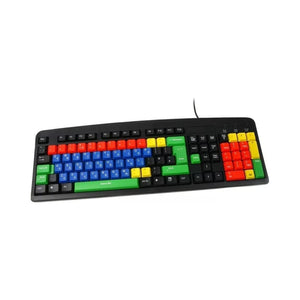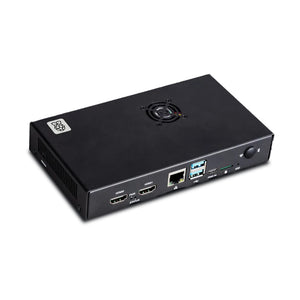There is a new IO Board launched along with the Raspberry Pi Compute Module 4 which has the work to break out all the interfaces from the device, Compute Module 4, to the standard connectors. If we elaborate on the specifications of the board then it consists of two full-size HDMI ports, Gigabit Ethernet jack, two USB 2.0 ports, a MicroSD card socket, PCI Express socket, 40-pin GPIO connector, 12V power input jack, camera and display connectors, and a real-time clock with battery backup.
Overview of Raspberry Pi Compute Module 4 IO Board
Raspberry Pi Foundation launched one of their magical and advanced products Raspberry Pi Compute Module 4 in as low as 25$. It has a compact form factor that increases the range of the usage of the users. It is the most awaited product among tech enthusiasts and now their wait is over. The IO Board is designed by the Raspberry Pi foundation to provide the exposure of every interface from Raspberry Pi Module 4. In simpler terms, the Compute Module IO Board works as a development platform and as a reference board design for one of the most powerful Compute Modules.
If we understand the utilization of the IO board, then Compute Module 4 IO Board is a Companion Board For Raspberry Pi Compute Module 4 which would be supplied separately. Raspberry Pi Foundation developed the IO board for use as a development system for the Compute Module 4. Raspberry Pi Compute Module 4 also works as an embedded board integrated into end products.
Raspberry Pi developed the design of the Compute Module 4 IO board to work with the “Off the Shelf Parts”. It makes a user utilize the board by connecting it with the HAT( Hardware Attached on Top) and PCLe Cards like NVMe, SATA, or USB. Many tech enthusiasts have the work to make the prototypes from the Compute Module 4 which makes the Compute Module 4 IO board perfect for their usage.
Specifications of Compute Module 4 IO Board
Raspberry Pi Foundation enhanced the Compute Module 4 IO Board than its predecessor to make the efficiency of the device higher. It has the CM4 socket that is designed to become suitable for all the variants of Raspberry Pi Compute Module 4. It has the standard Raspberry Pi HAT connectors with the POE(Power Over Ethernet) support. The PoE HAT allows you to power your Raspberry Pi using Power over Ethernet–enabled networks; for this product to be used, the network it is connected to needs to have power-sourcing equipment installed.
Raspberry Pi Compute Module 4 consists of Standard PCIe((Peripheral Component Interconnect Express) Gen 2 x1 socket where PCIe is a core technology used in many types of computer servers and endpoint devices. It works as a high-speed serial computer expansion bus standard that works as a common motherboard for computer’s WIFI, Ethernet, SSD, Hard drive, etc connections. It has the RTC or Real-Time Clock with battery backup which has the work to keep a track of the current time. The track of the time would be read by the microprocessor usually over a serial interface to ease the operations of the software that is dependent on the time readings.
Raspberry Pi Compute Module 4 consists of the Dual HDMI connectors with the Dual MIPI camera connectors and Dual MIPI(Mobile Industry Processor Interface) display connectors which allows the transmission of all video signal types - including high-definition signals up to Ultra HD 4K/60p. It supports Gigabit Ethernet socket PoE HAT that allows the user to utilize the Compute Module 4 IO Board for the high-speed internet. Compute Module 4 IO Board consists of On-board USB 2.0 hub with 2 USB 2.0 connectors that let the user connect their USB devices with the system. It allows the user to utilize exterior memory via the USB device. The IO Board comprises an SD card socket for Compute Module 4 variants without eMMC which one can use for the memory of the device. Compute Module 4 IP Board is developed to Support for programming eMMC(embedded multimedia card variants) of Compute Module 4. eMMC is advanced, managed NAND flash memory for mobile applications, and still is the dominant go-to memory solution for many consumer electronics like smartphones. Raspberry Pi Compute Module 4 comes with a PWM fan controller with tachometer feedback that varies the airflow and speed of a cooling fan using a pulse-width-modulated (PWM) voltage as per the temperature or system commands.
Configuration of the Compute Module 4 IO Board
The input power of the Compute Module 4 IO Board is 12V input, +5V input with reduced functionality (power supply not supplied). Raspberry Pi Compute Module 4 IO Board is gaining a lot of momentum in the popularity amongst its users that made the Raspberry Pi Foundation remain in production of it until at least January 2028. There are the following specification that has attracted the users to the Compute Module 4 IO Board
- External power connector (+12V, +5V)
- 2 x full-size HDMI 2.0 connectors
- 2 x USB 2.0 connectors, with a header for two additional connectors
- Gigabit Ethernet RJ45 with PoE support
- Micro USB socket for updating Compute Module 4
- MicroSD card socket for Compute Module 4 Lite (without eMMC) variants
- PCIe Gen 2 x1 socket
- Standard fan connector
- 2 x MIPI DSI display FPC connectors (22-pin 0.5 mm pitch cable)
- 2 x MIPI CSI-2 camera FPC connectors (22-pin 0.5 mm pitch cable)
- Standard Raspberry Pi HAT connectors
- Real-time clock with a battery socket and ability to wake Compute Module 4
- Various jumpers to disable specific features, e.g. wireless connectivity, EEPROM writing.
Instructions related to the safety
The user should understand that despite the advanced technology there are some safety instructions one needs to follow for efficient usage of the Raspberry Pi Compute Module 4. There are following instruction one need to follow
- Take care of the exposure of the water or moisture to the Compute Module 4 IO board as it can harm the device
- Raspberry Pi designed the Compute Module 4 IO board to work at a particular temperature limit. One should make sure that they perform the task on that given temperature limit.
- One should take care of the board while performing any electrical operations.








